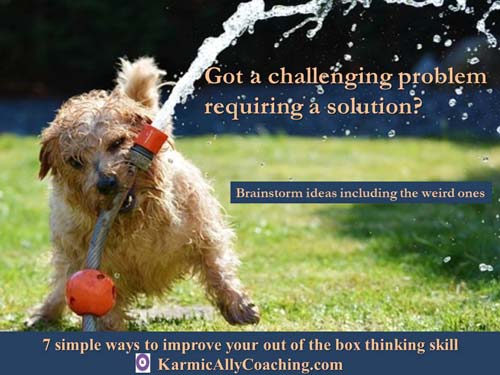This post has already been read 6988 times!

When you’ve applied out of the box thinking and presented a solution that would also improve productivity at work, how many times has it been accepted or applied?
How many times has it been chewed up and critiqued before the team has been ready to give the idea a shot?
I’m thinking about a friend who had a major pan department project that had to be completed but nobody knew how scope it leave alone how to do it.
She came up with a brilliant strategy after doing some out of the box thinking and then her superiors finally ‘woke up’ and applied their minds to it.
The final plan differed slightly to her original one but was a good one because an entire team was finally able to visualize the end goal and the process to get there.
Using the outside the box approach helped her to inspire others to share their wisdom and experience and when it came up at Board Level for approval, the CEO growled down anyone who raised objections!
Her efforts earned her accolades as she also applied the helicopter view.
Tip: If you want to strengthen your Executive Presence – master thinking outside of the square!
My friend was lucky that her superiors were open to new ideas and provide space for their staff to come up with new approaches but it isn’t always so.
Sometimes the answers that we seek won’t come from using our logical decision making on the perceived problem or trying to ‘fit’ the problem into our previous experience.
It will come from abandoning our assumptions and previous experience and looking at the problem from a new perspective.
In my post on developing the skill of having a helicopter view, I talk about being able to stand back from a task or activity and engage in both abstract and specific thinking.
Sometimes I feel the phrase Think outside the box is bandied about by managers and team leaders because it’s the ‘in’ phrase to use without actually considering the actual meaning of the phrase.
Truth of the matter is, some managers and bosses do not even want out-of-the-box thinkers, no matter what they say to the contrary.
During my corporate career, I worked for bosses who wanted their people to be creative in problem solving while others wanted to follow the rules and frameworks even some of them made no sense in the situation.
I agree that certain positions require rules to be followed like those of auditors whose work involves checking for compliance and risk management of their clients as well as checking the accuracy of the finances of their clients.
The times when creativity has been allowed in has also been the time when corporations like Enron have fallen, top accounting firms have collapsed and regulations like Sarbanne Oxley have been enacted.
Closer to home in India, the Satyam case led to 2 partners in a Big 4 firm – one on the verge of retirement and one partner who was signing his first balance sheet- being put in jail and the Securities and Exchange Bureau of India revamping rules!
This post is looking at the need to be adaptable and think on one’s feet to find solutions where none seem possible. We’re addressing creative thinking.
What’s thinking outside the box?

According to Wikipedia, Thinking outside the box (also thinking out of the box or thinking beyond the box and, especially in Australia, thinking outside the square) is a metaphor that means to think differently, unconventionally, or from a new perspective.
This phrase often refers to novel or creative thinking. The term is thought to derive from management consultants in the 1970s and 1980s challenging their clients to solve the “nine dots” puzzle, whose solution requires some lateral thinking.
Going against conventional wisdom or trying a unique approach to a situation can yield the desired results provided you are open to applying the brainstorming ideas that emerge from thinking outside the box.
In my blog post Problem Solving by Coco the Cock a Tzu
the first problem solving tip that my furry friend shared was creative thinking, or what we call thinking out of the box.
Here’s an anecdote that I had read a few years back about how a bit of imagination and creative thinking can solve problems.
I’ve seen different variations of this story and even discovered some history about its origins (including it being an urban legend and dating back to the 1880s) but I love this version the best.
How creative thinking got a potato garden digging done
An old man lived alone in Minnesota. He wanted to spade his potato garden, but it was very hard work.
His only son, who would have helped him, was in prison. The old man wrote a letter to his son and explained his situation:
Dear Son,
I am feeling pretty bad because it looks like I won’t be able to plant my potato garden this year. I hate to miss doing the garden, because your mother always loved planting time. I’m just getting too old to be digging up a garden plot. If you were here, all my troubles would be over. I know you would dig the plot for me, if you weren’t in prison.
Love,
Dad
Shortly, the old man received this telegram: “For Heaven’s sake, Dad, don’t dig up the garden!! That’s where I buried the money!!”
At 4 a.m. the next morning, a dozen FBI agents and local police officers showed up and dug up the entire garden without finding any money.
Confused, the old man wrote another note to his son telling him what happened, and asked him what to do next.
His son’s reply was: “Go ahead and plant your potatoes, Dad. It’s the best I could do for you from here.”
Moral: Just be a little imaginative and see what happens!
This is a good example of what thinking outside of a box is and if you can master that skill, then you gain brownie points for demonstrating executive presence – grace under fire and projecting vision – both important elements of the elusive gravitas.
So far I’ve focused on what it means to think outside the box. This is a skill that anyone can learn and apply, whether at work, at home or even for our own professional development.
Now we’ll focus on simple ways to effectively start thinking outside the box. Some are personal actions and others will require your ability to get active participation from others.
How to jump start thinking out of the box and improve your productivity
Step away from the situation or task and take a break
This is my favourite method and one of the hardest to apply when one is engrossed in problem-solving and yet it works wonders.
Creative thinking doesn’t flourish inside a silo and it’s important to get away from routine tasks in order to give the mind a chance to come up with ideas.
In my student days I found taking a shower whenever my brain got bogged down helped a lot during exam preparation time. The accountancy exams were tough and I had to strategize as well as learn information to pass those exams.
When I passed my exams, the other girls in my dormitory also adopted my ritual although essentially, all that I had needed was a break!
I doubt your firm will install an office shower area to encourage out of box thinking so another way is to take a break or walk around.
It could be to the coffee machine or even outside the premises to get away from the problem – anything to create a psychological distance between the task and time for creative thinking to set in.
My team and I used to do a lot of walking in the compound while discussing issues and I was pleasantly surprised to learn later that even Steve Jobs used to hold walking meetings to brainstorm ideas!
Change your routine
Sometimes a minute change to a regular routine can get your brain thinking differently. When we do the same chore in the same way, we get set in patterns that don’t allow us to think differently.
A little variation that changes the routine helps you get out of a rut and encourages out of the box thinking which can have bigger results later on.
Essentially, when you get outside of your comfort zone, you develop coping skills that help you to deal with new situations because you have already opened your mind to new possibilities, ideas and options.
Wondering how to change the routine? Here are 2 that instantly come to my mind.
If there are different routes to your workplace, try 1 route driving in to work and another while coming back. Think of using the metro on particular days if there is public transport access between your home and office.
Keep 1 day aside for pizza or some special meal with your family or friends instead of cooking at home.
View the problem from a different perspective
In other words, reframe the problem or question to see if you can discover a new solution, see the issue from a new perspective or re-conceptualize the problem.
One popular way is to decide if you wish to see the glass half full or half empty.
When the perspective changes from seeing something is missing to acknowledging that there is something already, new avenues emerge to take things forward using existing building blocks.
Another way is to work backwards. In the words of Covey, begin with the end in mind Popularized as ‘reverse engineering’, we look at our end goal and then work backwards to see how it can be best achieved.
For example when a leading top of the range beauty product manufacturer wanted to enter the Indian market a decade ago, they knew they wanted to capture a good market share.
But why would any woman want to spend double the price of other leading and equally good products, both local and international on a brand that was only known to women who had travelled abroad?
I saw this one in action. I knew the product range as I had used it before and loved the way they built up their reputation.
Knowing that the end game was to get the ladies hooked on their product range, they teamed up with a magazine that often held promotions.
One of my friends was the deputy editor there at the time so I got an invitation to a presentation at a 5 star hotel with high tea.
Each of the 100 women present were not only introduced to the products, but there were live presentations, mini-facials and a goodie bag with prescribed skincare products as well as an invitation to visit their parlour cum shop.
The entire event would have cost a fortune but the end goal was achieved. They got fans and clientele and I saw women signing up for further treatments without flinching at the price list.
Brainstorm ideas and don’t worry if some of them are weird
This is another great way to get those grey cells working!

In this exercise, we aren’t looking at what’s feasible and what’s not but getting out of our old thought patterns by thinking of different ideas, even the weird ones.
Got a challenging problem requiring a solution?
Take a piece of paper and pen and set your timer for 10 minutes and jot down as many ideas as you can without thinking if it is doable or not.
For example, if you’ve got low metabolism, want to shed the extra weight and need ideas to achieve your goal, you might think of low fat meal plans, exercising, joining a gym or even washing elephants at the zoo.
The last one might appear weird to start with but it is a good idea if your local zoo allows you to do it voluntarily – besides, you’ll burn those calories and learn about elephants!
Once you come up with the ideas then have a look at what can be done and what can’t. I know you’ll find some good ones in your list.
If brainstorming a list isn’t your cup of tea, then here’s another idea that works to get thinking.
We start with the pen, paper and problem and then change our strategy.
We write down a step by step plan on exactly how we intend to complete the challenging task.
Once that’s done, we look at this plan and the steps and think about how we can do each step differently and still achieve results.
Let go of negative thinking
It goes without saying that thinking negative thoughts doesn’t help in problem solving with 1 exception which I will share later.
The skill of thinking outside of the box benefits from positive thinking because when we think positive thoughts we step into the realm of possibility thinking and creativity gets a boost.
If you find yourself responding negatively to your ideas, replace the negative thought with a positive or neutral thought.
The next time you have an idea replace the inner talk of something not being possible with one that accepts the idea will be challenging but that you are still going to give it a shot.
Check out my blog post on negative thinking for more tips on letting go of negative thoughts.
Consider the worst case scenario.
Fear often paralyzes us from doing what we know we have to do and is a damper when it comes to thinking outside the box.
The best way to shove fear out of the way is to either accept it and plod on or better still, take the sting out of it by first imagining the worst case scenario and then allowing your creativity to take control.
In my blog post Take the sting out of Fear of Failure it’s only a Belief, I share the 3 step approach to overcoming fear and finding solutions that work as well as the inspiring Willis Carrier story.
Nourish your brain to be at its best
Exercising our brain helps it to enable us to find those previously un-thought-of solutions.
Like any skill, creativity too needs to be exercised so that it comes up with ideas when you really need them.
Here are 2 ideas for nourishing your brain and keeping it active.
Keep learning something new to broaden your horizons and perspectives and enable your brain to make new connections. The more information your brain has access to, the more it’s able to come up with unusual ideas. It could be a course in your field of specialization that adds to your knowledge, another field of study that is different to your own, learn a new language or even a hobby class!
The other tip is to reinforce your connection with other people who are creative. When we interact with other people, they offer us a different perspective on things and can actually inspire us to achieve more creative out of the box ideas.
It helps to befriend people who are from a field that is different to yours because they can give you perspectives on your work and life that you wouldn’t get from people in your own field when it comes to developing your skill.
No offense meant but unless they too are working on their creative muscles, you’d all be drinking from the same well and coming up with the same ideas. What you are seeking is ideas that would challenge you to step out of your comfort zone and try something unique.
Consider joining a mastermind or group of professionals who are either going through similar experiences or are trying to achieve a similar goal. Sharing experiences and learning often leads to our own aha moments and one of the reasons why group coaching is popular.
Out of the box thinking – Final Thoughts
As with all ideas, we need to test them to make sure they work. Sometimes, the out of the box solution might not be the right one or might sound good on paper but will not be doable in the real world scenario.
That’s why when my friend came up with her out of the box solution; it did undergo changes before the final version to make it workable based on the experience of her senior colleagues who brought their own experience into the picture.
But that would not have happened until she had brought in her ideas which inspired creativity in others and the emergence of a better idea and plan as a team.
And that’s what out of the box thinking is about!
How do you find solutions to sense defying problems?
Need more help? Try this resource to get your imagination working in top order.





 I adhere to the Certified Coaches Alliance Code of Ethics and Standards. A copy is available on request.
I adhere to the Certified Coaches Alliance Code of Ethics and Standards. A copy is available on request.
 Let's Talk through the Connect Form:
Let's Talk through the Connect Form:
The 3 I love the most is view from a different perspective, brainstorm and nourish the brain… I have always felt this was so important.
I agree Heather. The more information we give our brain and the more opportunities we give it to think, we create better solutions while also improving our intuition.
When I retired and took up writing full time, I made myself a vow to not only feel free to think outside the box, but to get rid of the box all together! I am now free to be me!
Awesome Barb! I know getting rid of the box has allowed you to find the freedom for self-expression. Bravo!
I love using creativity and logic together to come up with new solutions. I teach these concepts to my clients. The world needs more out of the box thinkers now more than ever.
I agree with you Lisa. Learning the skill of parallel thinking is a must in today’s world.
Creativity counts — whether in the business world or other endeavors. I also loved learning the phrase “out of the square” thinking. Thanks for sharing.
I agree Andrea. I was amused when I first learned of the phrase ‘out of the square’ but then remembered a Jamaican saying about fitting square pegs in round holes. The same meaning of discovering solutions to brain fatiguing challenges. 🙂
As a Gestalt thinker, I often think outside the box and then bring it in…if it fits. This has always been my style of thinking and I am thrilled when I meet others, like you Vatsala, who are not afraid to venture outside that box, too. Loved your article.
Thanks Kathleen! 🙂
Just love the gardeners story, wow that was creative out of the box thinking. aI do think creatives have different ways of thinking, brains maybe wired in a different way.
yes to letting go of negativity
great suggestions thank you xx
That story is a favorite of mine too, Suzie, and there is a Hindi version that I learned at school where a farmer on his deathbed tells his lazy sons that he has buried diamonds in the field and they end up digging the place up but find nothing. Since they’ve already dug up the place, they plant the seeds and then look after the fields where corn is grown. They realize the lesson their father has taught them because they earn money after selling the corn!
Creatives do think differently and are open to multi-dimensional thinking which in itself helps them to think outside the box.
I love the story you use to illustrate the point.
For me when I need solutions I often turn to meditation, or my orange le cards to help find creative solutions. Not such a great corporate toll but it works well for me in my world.
Thanks Anita. I too turn to meditation and my angel cards for guidance and sometimes even pray for guidance and it works. I would categorize such activities as taking a break and stepping back from the situation as well as trying a new perspective where we tap into our intuition.
Thank you for this wonderful article. I love the results of thinking outside the box, yet, I tend to stay within the lines to meet the masses. This is a great reminder for me to not worry about being weird.
Being weird too can lead to out of the box thinking, Fran, so my advice is to keep being you and being great at it!
Over the past twenty-something years I’ve learned to stop, think and imagine what it would be like to think outside of the box. I’ve always thought differently from most, putting the needs of others first rather than selfish pursuits. Now, thinking outside of the box is as you say…the in thing…not for me, I want to remain different and by unconventional thinking I will remain me, unique and fun.
It looks like you do engage in thinking outside the box, Carla, dear friend, because you entertain unconventional thinking. It’s subtle in your case but it’s there! Welcome to the Club!